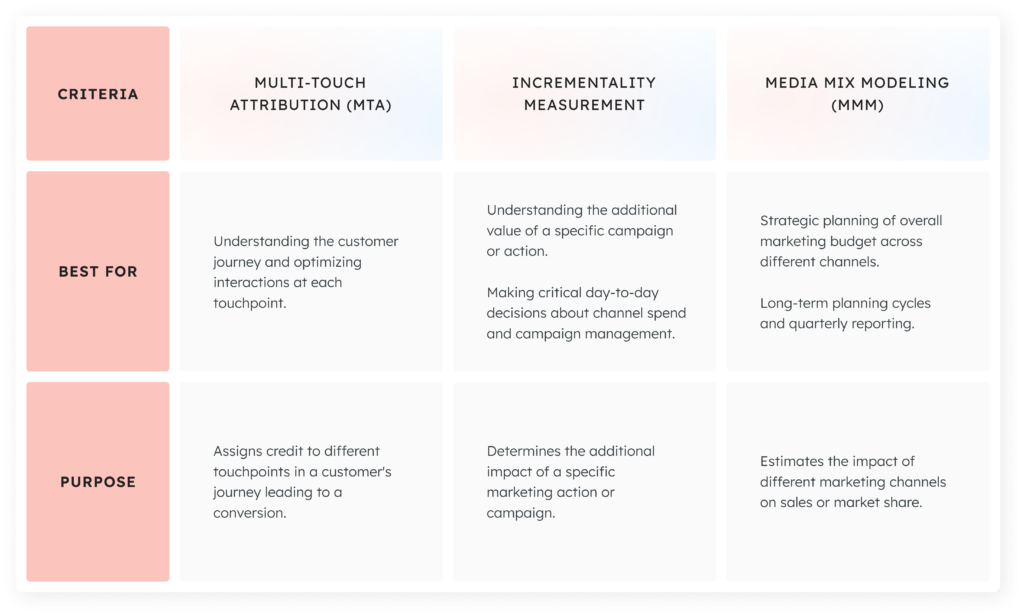“Half the money I spend on advertising is wasted; the trouble is I don’t know which half”.
The credit for this timeless quote goes to John Wanamaker (1838-1922), a successful American department store magnate. Fast forward one hundred years later…and marketers are still struggling with the same problem.
The goal of incrementality is to answer the question: “If we hadn’t run this campaign, what would our results have looked like?” Or, in other words, how much of my advertising spend is working for me?
Incrementality measurement determines how a specific marketing tactic has impacted a given outcome. Measuring incrementality enables businesses to better understand which marketing efforts are actually driving results, so that they can optimize their future strategies accordingly.
Here’s an example:
An online retailer runs a marketing campaign that results in a 10% increase in sales.
A resounding success…right?
But wait. Is it possible that some of these sales could have occurred even without the campaign?
Consider this example from Avinash Kaushik.
If you spend an additional $10,000 on some marketing campaign(s), how many additional sales would you drive? Or vice versa: If you spent $10,000 less, how many sales would you really lose?
You may wonder: Can’t I tell exactly that from my multitouch attribution campaign performance reports?
No. You can’t. Unfortunately.
Some people who clicked on your ads and purchased would have made the purchase anyway. Even without seeing the ad. Because their friends told them, or because they already knew your brand.
But multitouch attribution can’t see that and (wrongly) assigns credits to these ad clicks. Consequently, you risk spending your ad money in the wrong place. That’s exactly what incrementality measurement can fix.
Why is incrementality so important to marketing strategy?
Incrementality measurement is designed to isolate the effect of the campaign by comparing the results of the group exposed to the campaign (test group) and the group not exposed to the campaign (control group).
Incrementality measurement can help you:
- Understand the business impact of a marketing channel beyond the results from the platform analytics report.
- Understand which media investments affect ROI and to what extent.
- Identify areas of wasteful spending.
- Discover opportunities to scale successful initiatives.
- Expand or reallocate media budget for better results and growth.
How is incrementality different than attribution?
Attribution: The science of distributing credit for conversions.
- Often only measures correlation, but not necessarily causation.
- Many tools try to identify causation to varying degrees of success, but they tend to attribute more revenue to channels with website engagement.
- This can attribute credit to ads that did not matter.
- Which, in turn can drive advertisers and media buying systems to invest in the wrong campaigns.
Incrementality: Identifies the conversions that would not have occurred without specific marketing tactics.
- Measures the revenue caused by a channel.
- Reveals campaigns that look good but don’t drive additional value.
- Helps identify profitable campaigns that don’t get the credit and investment they deserve.
Which common digital marketing tactics tend to drive high incremental value? Which tactics tend to drive low incremental value?
The following digital marketing tactics tend to drive high incremental value:
- Paid search: Generics
- Why? Paid search can be highly incremental, because it can reach users that aren’t aware of your brand yet. A user might type in a generic keyword such as “dresses online” without a specific shop in mind. If this person clicks on one of your ads and makes a purchase, this purchase is incremental to your business as it wouldn’t have happened if the user hadn’t seen the ad from this particular channel. A highly competitive environment of different advertisers competing for attention in the same auction is also a sign of high incrementality.
- Paid social and display: prospecting campaigns
- Why? The paid social audience is often not at all or newly aware of your brand, OR in the consideration stage of the purchase. This is because social media users don’t necessarily come to platforms with the intent to buy. As a result, the nominal ROAS of paid social is usually lower than other, non-incremental channels, leading to it being undervalued by retailers when in reality, it drives high incremental value. The incremental ROAS could be very high and may be overlooked.
- Any paid campaign targeting new customers
- Why? Any campaign that can turn a new audience with little to no touchpoints with your business into customers, can be a valuable source of growth and long-term profitability.
The following tactics tend to drive low incremental value:
- Any paid campaigns targeting loyal customers
- Why? Active loyal customers who are already familiar with the brand and regularly make purchases. Ad platform targeting is very well developed to recognize a high buying propensity of loyal customer types and show ads accordingly. It is the inverse of causality: users are targeted because they are going to purchase, not to remind them to come back to the business.
- Paid search: Brand campaigns.
- Why? A customer who entered the website via paid search pure brand is already familiar with the website. When pure brand has no competition on Google ads, the customer would use the organic link. Our opinion is that brand ads can remain active if CPCs (cost per click) are low, but do not assign too much for the purchase to this brand ad.
- Paid social and display: retargeting customers:
- Why? Even when a paid social channel like Display Retargeting, is generating high revenue at a high ROAS, it may have low incremental value. This is because purchases from Retargeting are likely to have originated on earned channels such as Direct or Organic Search. The most common example is retargeting of cart viewers who are already far in their purchase process. This may include existing or new customers.
How can I measure incrementality?
Incrementality can be measured for any channel that:
- Makes a significant contribution to your business
- Allows you to carry out a random controlled experiment.
The gold standard of incrementality testing is to run your own randomized controlled experiment based on the channels you have running or new channels you want to test.
If you already have a marketing channel running, you can turn it off and see how much revenue you lose.
If you don’t have a channel running, you can turn it on and see how much revenue you gain.
You can leverage ad platform features like geotargeting to design and carry out experiments.
Of course, it’s important to control for other variables that may skew your results. Seasonality is a big one.
For example, if you ran an incrementality test with Instagram prospecting ads in two different geo- locations with different stay-at-home restrictions during the COVID lockdowns, your results could be invalid because an uptick in revenue could be attributed to more shoppers being stuck inside.
If you are nervous about losing revenue but interested to understand the incremental value of your current channels, reach out to our team for guidance on this. We frequently work with clients to design and analyze geo-experiments across multiple ad platforms.
How do you calculate/evaluate the incremental impact of a channel?
- Split users into two groups.
- Show Group #1 ads.
- Don’t show any ads to Group #2
- Measure the success metric for each group of users (e.g. sessions, revenue)
- Divide by the number of users to see a fair comparison between the groups.

The difference in performance between the Group #1 and Group #2 shows the incremental impact of the advertising channel. In this example, the incremental revenue per user is $10. In other words, this $10 per user would not have been generated without the advertising campaign.
To calculate incremental return on investment (ROAS):

Once you understand incremental ROAS, you can determine if this campaign is a valuable use of your ad spend, based on your cost of acquisition and profit margins.
What is MTA vs Incrementality Measurement vs MMM?

What’s next?
Interested in understanding how to use predictive intelligence to target and win the best customers? Learn about our iCLV platform—which helps you to track, predict, activate, and report across paid search and paid social.




